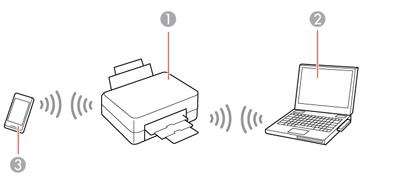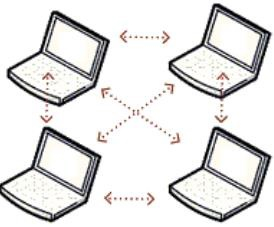
 Data Structure
Data Structure Networking
Networking RDBMS
RDBMS Operating System
Operating System Java
Java MS Excel
MS Excel iOS
iOS HTML
HTML CSS
CSS Android
Android Python
Python C Programming
C Programming C++
C++ C#
C# MongoDB
MongoDB MySQL
MySQL Javascript
Javascript PHP
PHP
- Selected Reading
- UPSC IAS Exams Notes
- Developer's Best Practices
- Questions and Answers
- Effective Resume Writing
- HR Interview Questions
- Computer Glossary
- Who is Who
Differentiate between ad-hoc mode and Wi-Fi Direct mode in 802.11 architecture
Let us understand what a Wi-Fi Direct mode is.
Wi-Fi Direct Mode
The Wi-Fi Direct is built upon the same Wi-Fi technology used by most modern consumer electronic devices to communicate with wireless routers. It allows two devices to communicate with each other, provided that at least one of them is compliant with the standard to establish a peer-to-peer connection. Wi-Fi Direct is supported by more devices than most people realize.
This mode is shown below −

Here,
- 1 is the Printer
- 2 is the Computer with a wireless interface
- 3 is the Mobile or Another wireless device.
Ad-Hoc mode
Collections of computers are associated so that they can directly send frames to each other. There is no Access Point in Ad hoc, because Internet access is the killer application for wireless. Ad hoc networks are not very popular.
This mode is shown below −

Differences
The major differences between Wi-Fi direct and Ad hoc mode are as follows −
| Parameters | Wi-Fi Direct mode | Ad-hoc mode |
|---|---|---|
| What is it? | In Wi-Fi direct mode, the communication occurs between the wireless nodes and access points, but not directly between wireless nodes |
In ad-hoc mode, no access point is required because every node communicates directly with other nodes. |
| What about External Communication? | Access points acts as, a bridge to another wireless/wired network |
If nodes are within the same range they can communicate. |
| Are Physical needs required? Complexity of modes |
Physical infrastructure is needed in Wi-Fi direct mode Designing is simple because most of the network functionality lies within AP and the client is just a simple machine. |
No physical infrastructure is needed in ad hoc mode. As no central coordination exists, we can use decentralized MAC protocols such as CSMA/CA, with all nodes having the same functionality. This shoots up the complexity and cost. |
| When it cannot be used? Applications Channel Access Topology of modes |
It can’t be used in critical situations like disaster relief where no infrastructure is left. IEEE 802.11 & HIPERLAN2 are based on Wi-Fi direct mode. Most infrastructure-based WLAN uses TDMA-based protocols Based on topology the Wi-Fi, one main advantage is the ability of infrastructure WLANs to provide wired network applications and services |
It is not always fully connected as two mobile nodes may temporarily be out of range. Bluetooth is a typical ad-hoc network. Most Ad-hoc based WLAN uses contention MAC protocols (e.g. CSMA) Ad-hoc WLANs are easier to set-up and they require no infrastructure |

